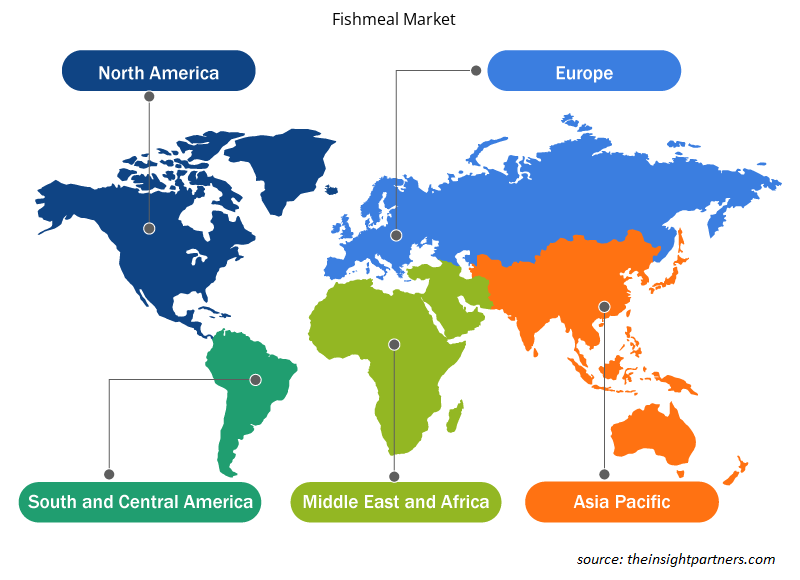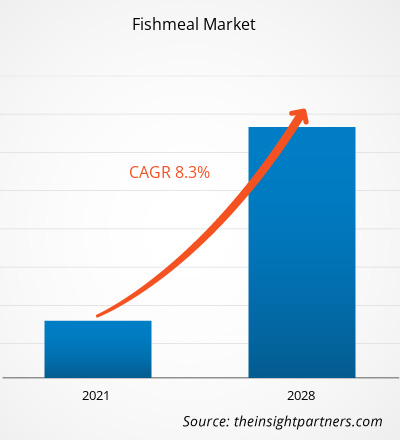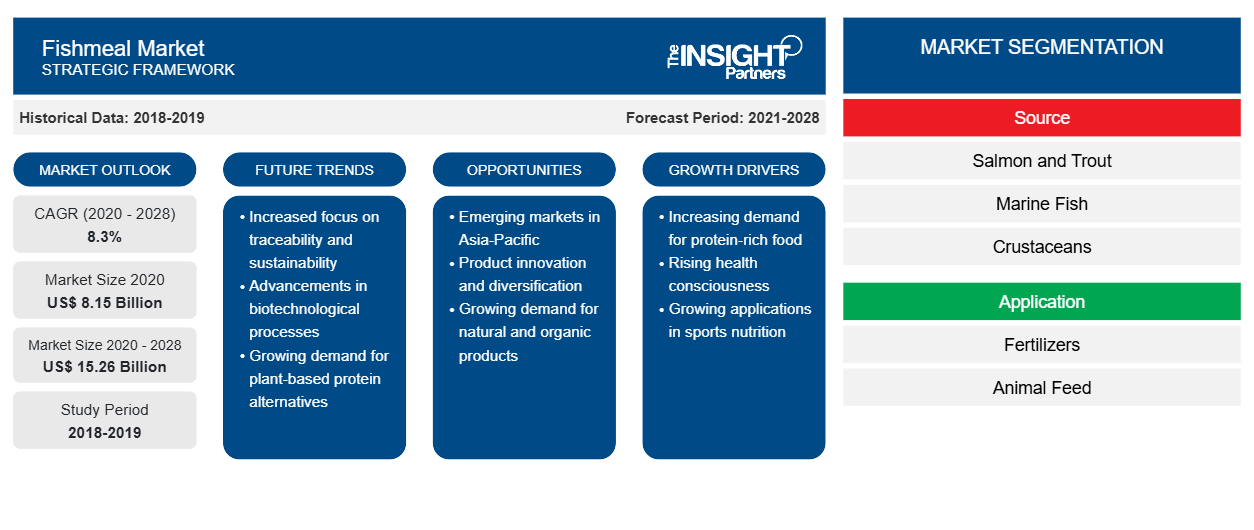El mercado de harina de pescado se valoró en US$ 8.153,6 millones en 2020 y se proyecta que alcance los US$ 15.264,6 millones en 2028; se espera que crezca a una CAGR del 8,3% entre 2021 y 2028.
La harina de pescado se produce a partir de subproductos de pescado de las industrias de procesamiento y fileteado de alimentos. Se utiliza principalmente como ingrediente de alto contenido proteico (60-72%) en piensos producidos para animales de granja y especies de acuicultura. La demanda de harina de pescado supera la oferta; por lo tanto, la industria de piensos ha cambiado considerablemente la composición de la harina de pescado en los piensos. El mercado de la harina de pescado ha sido testigo del crecimiento a lo largo del período histórico debido al desarrollo de la acuicultura debido a la creciente demanda de productos del mar y la creciente dependencia de la acuicultura por parte de los países en desarrollo para resolver la escasez de alimentos. Además, la harina de pescado es sostenible por naturaleza, ya que se produce a partir de componentes de desecho de otras industrias. Por lo tanto, forma parte de varios programas de conservación ambiental. De este modo, el mercado se beneficia de prácticas sostenibles, como la agricultura orgánica.
En 2020, Asia-Pacífico tuvo la mayor participación en los ingresos del mercado mundial de harina de pescado . Además, se espera que la región registre la CAGR más alta durante el período de pronóstico. Asia-Pacífico comprende varias economías importantes como India, China, Japón, Corea del Sur y Australia. Estos países están presenciando un aumento en la industrialización en el sector alimentario y las actividades de urbanización, ofreciendo amplias oportunidades para los actores clave en el mercado de harina de pescado. Se anticipa que Asia-Pacífico será testigo de una creciente demanda de harina de pescado en los próximos años debido a la presencia de numerosos actores nacionales de nivel pequeño y mediano en el mercado. Durante el período de pronóstico, se espera que el mercado de harina de pescado sea testigo de una gran demanda de las industrias de acuicultura y agricultura orgánica debido a su perfil altamente nutritivo que contiene aminoácidos esenciales. Además, la harina de pescado encuentra aplicaciones en las industrias nutracéutica, farmacéutica y otras. Se espera que el mercado de harina de pescado en Asia-Pacífico crezca durante el período de pronóstico debido al enorme crecimiento en el sector de la acuicultura, especialmente en India y China. Además, el aumento de la población y el creciente apoyo gubernamental están impulsando el crecimiento del mercado en la región.
Personalice este informe según sus necesidades
Obtendrá personalización en cualquier informe, sin cargo, incluidas partes de este informe o análisis a nivel de país, paquete de datos de Excel, así como también grandes ofertas y descuentos para empresas emergentes y universidades.
- Obtenga las principales tendencias clave del mercado de este informe.This FREE sample will include data analysis, ranging from market trends to estimates and forecasts.
The COVID-19 pandemic has negatively impacted the fisheries industry with disruptions in its supply chain. The decline in the demand for seafood has resulted in the decreased production of fish. Low fish demand reduced fish fleet activities, which negatively impacted the production of fish by-products, especially fishmeal. However, with the launch of vaccination drives globally, the economies are reviving, and industries are witnessing demand for their products. Various governments are also taking initiatives to minimize the loss of the fisheries industry due to this pandemic. With this, the fishmeal market is expected to witness growth in the coming years.
Market Insights
Increasing Demand for Protein Rich Animal Feed
The industrialization of animal farming has increased the demand for protein-rich animal feed ingredients to raise the feed conversion rate. Industrially raised livestock are mainly fed on concentrates made from cereal and vegetable protein such as soybean meals to assist them in gaining weight and producing protein-rich meat. Farm animals depend on proteins and other elements as building blocks essential for growth. Proteins in animal feeds are an excellent energy source and essential amino acids, such as lysine and methionine. The growing awareness about the health benefits of proteins on animal health has created a substantial demand for various protein feeds, such as animal protein meals, feather meals, fishmeal, bone meal, and blood meal. Fishmeal is a rich source of protein, minerals, and fatty acids and is easily digested by the livestock upon consumption. High-quality fishmeal enables the formulation of nutrient-dense livestock diets, promoting their optimal growth. As livestock and farm animals contribute significantly to the global food supply chain, the demand for protein-rich nutritious animal feed is rising and is expected to continue during the forecast period. The constantly burgeoning demand for protein-rich animal feeds to promote growth in livestock at all stages of life is driving the overall fishmeal market substantially.
Source Insights
Based on source, the global fishmeal market is segmented into salmon, mackerel, anchovy, capelin, and others. In 2020, the anchovy segment accounted for the largest revenue share. Anchovies are majorly found in SAM, especially in Peru. The volume of fishmeal production manufactured from Peruvian anchovies is equivalent to the requirement of half of the global fed farmed fish production. The market for the anchovy segment is expected to witness growth during the forecast period due to the availability of anchovies in ample quantity. The high availability of anchovies also has a positive impact on the global food security.
Application Insights
Based on application, the global fishmeal market is segmented into animal feed, agriculture, and others. In 2020, the animal feed segment accounted for the largest revenue share. Fishmeal is a highly digestible feed ingredient, carrying a high amount of energy per unit weight. It contains little carbohydrate and is an excellent source of vitamins, minerals, oils (lipids), and proteins. Many commercial fishmeal are made from small and bony fishes, which are not suitable for consumption by human or manufactured from by-products of the fish processing industry. Therefore, the valorization of by-products makes the fishmeal animal feed economical. Hence, the enhancement of animal feed with the help of fishmeal is driving the market growth for this segment.
TripleNine, The Scoular Company, FF SKAGEN A/S, Pelagia AS, Soytex LTD, Pesquera Diamante S.A., TASA, Oceana Group Limited, Omega Protein Corporation, and COPEINCA are a few well-established players in the global fishmeal market. Companies in the market are adopting strategies such as product developments, plant expansions, and mergers and acquisitions to expand their footprint worldwide and meet the growing demand from end users. For instance, in September 2021, Scoular launched a new brand Encompass for its growing fishmeal business.
Fishmeal Market Regional Insights
The regional trends and factors influencing the Fishmeal Market throughout the forecast period have been thoroughly explained by the analysts at Insight Partners. This section also discusses Fishmeal Market segments and geography across North America, Europe, Asia Pacific, Middle East and Africa, and South and Central America.

- Get the Regional Specific Data for Fishmeal Market
Fishmeal Market Report Scope
| Report Attribute | Details |
|---|---|
| Market size in 2020 | US$ 8.15 Billion |
| Market Size by 2028 | US$ 15.26 Billion |
| Global CAGR (2020 - 2028) | 8.3% |
| Historical Data | 2018-2019 |
| Forecast period | 2021-2028 |
| Segments Covered | By Source
|
| Regions and Countries Covered | North America
|
| Market leaders and key company profiles |
|
Fishmeal Market Players Density: Understanding Its Impact on Business Dynamics
The Fishmeal Market market is growing rapidly, driven by increasing end-user demand due to factors such as evolving consumer preferences, technological advancements, and greater awareness of the product's benefits. As demand rises, businesses are expanding their offerings, innovating to meet consumer needs, and capitalizing on emerging trends, which further fuels market growth.
La densidad de actores del mercado se refiere a la distribución de las empresas o firmas que operan dentro de un mercado o industria en particular. Indica cuántos competidores (actores del mercado) están presentes en un espacio de mercado determinado en relación con su tamaño o valor total de mercado.
Las principales empresas que operan en el mercado de harina de pescado son:
- Triple nueve
- La Compañía Scoular
- FF SKAGEN A/S
- Pelagia AS
- Soytex Ltd.
Descargo de responsabilidad : Las empresas enumeradas anteriormente no están clasificadas en ningún orden particular.

- Obtenga una descripción general de los principales actores clave del mercado de harina de pescado
Informe Destacado
- Tendencias progresivas de la industria en el mercado mundial de harina de pescado para ayudar a los actores a desarrollar estrategias efectivas a largo plazo
- Estrategias de crecimiento empresarial adoptadas por los mercados desarrollados y en desarrollo
- Análisis cuantitativo del mercado mundial de harina de pescado de 2019 a 2028
- Estimación de la demanda de harina de pescado en diversas industrias
- Desarrollos recientes para comprender el escenario competitivo del mercado y la demanda de harina de pescado
- Tendencias y perspectivas del mercado junto con los factores que impulsan y restringen el crecimiento del mercado de harina de pescado
- Proceso de toma de decisiones mediante la comprensión de las estrategias que sustentan el interés comercial con respecto al crecimiento del mercado mundial de harina de pescado
- Tamaño del mercado de harina de pescado en varios nodos del mercado
- Descripción detallada y segmentación del mercado mundial de harina de pescado, así como su dinámica en la industria.
- Tamaño del mercado de harina de pescado en varias regiones con oportunidades de crecimiento prometedoras
Mercado de harina de pescado, por origen
- Salmón
- Caballa
- Anchoa
- Capelán
- Otros
Mercado de harina de pescado, por aplicación
Perfiles de empresas
- Triple nueve
- La Compañía Scoular
- FF SKAGEN A/S
- Pelagia AS
- Soytex Ltd.
- Pesquera Diamante SA
- TASA
- Grupo Oceana Limitada
- Corporación de Proteínas Omega
- COPEANCA
- Análisis histórico (2 años), año base, pronóstico (7 años) con CAGR
- Análisis PEST y FODA
- Tamaño del mercado, valor/volumen: global, regional y nacional
- Industria y panorama competitivo
- Conjunto de datos de Excel
Informes recientes
Testimonios
Razón para comprar
- Toma de decisiones informada
- Comprensión de la dinámica del mercado
- Análisis competitivo
- Información sobre clientes
- Pronósticos del mercado
- Mitigación de riesgos
- Planificación estratégica
- Justificación de la inversión
- Identificación de mercados emergentes
- Mejora de las estrategias de marketing
- Impulso de la eficiencia operativa
- Alineación con las tendencias regulatorias























 Obtenga una muestra gratuita para - Mercado de harina de pescado
Obtenga una muestra gratuita para - Mercado de harina de pescado